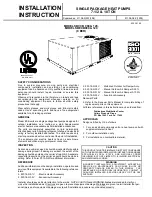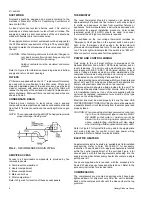
HEAT ANTICIPATOR SETPOINTS
It is important that the anticipator setpoint be correct. Too high
of a setting will result in longer heat cycles and a greater
temperature swing in the conditioned space. Reducing the
value below the correct setpoint will give shorter “ON” cycles
and may result in the lowering of the temperature within the
conditioned space. Refer to Table 8 for the required heat
anticipator setting.
CHECKING SUPPLY AIR CFM
The RPM of the supply air blower will depend on the required
CFM, the unit accessories and the static resistances of both
the supply and the return air duct systems. With this
information, the RPM for the supply air blower can be
determined from the blower performance data in Table 4.
Knowing the required blower RPM and the blower motor HP,
the setting (turns open) for the supply air motor pulley can be
determined from Table 9.
BELT DRIVE BLOWER
All units have belt drive single-speed blower motors. The
variable pitch pulley on the blower motor can be adjusted to
obtain the desired supply air CFM. Refer to Table 6 for blower
motor and drive data.
Start the supply air blower motor. Adjust the resistances in both
the supply and the return air duct systems to balance the air
distribution throughout the conditioned space. The job
specifications may require that this balancing be done by
someone other than the equipment installer.
To check the supply air CFM after the initial balancing has been
completed:
1. Remove two dot plugs from the filter access and the blower
access panels as shown in Figure 4.
2. Insert at least 8" of 1/4 inch tubing into each of these holes
for sufficient penetration into the air flow on both sides of
the indoor coil.
NOTE: The tubes must be inserted and held in a position
perpendicular to the air flow so that velocity pres-
sure will not affect the static pressure readings.
3. Using an inclined manometer, determine the pressure drop
across a dry indoor coil. Since the moisture on an indoor
coil may vary greatly, measuring the pressure drop across
a wet coil under field conditions would be inaccurate. To
assure a dry coil, the compressors should be deactivated
while the test is being run.
4. Knowing the pressure drop across a dry coil, the actual
CFM through the unit can be determined from the curve in
Figure 10.
WARNING: Failure to properly adjust the total system air quan-
tity can result in extensive blower damage.
After readings have been obtained, remove the tubes and seal
up the drilled holes in the side panels. 5/16" dot plugs (P/N
029-13880) are available through normal parts ordering
procedures.
HEATER
KW
VOLTAGE
SETTING, AMPS
TH1
(Compr.)
TH2
(Suppl. Ht.)
9
18
24
36
54
208/230-3-60
1.10
1.10
1.10
1.10
1.10
0.40
0.90
0.90
0.90
0.90
9
18
24
36
54
460-3-60
1.10
1.10
1.10
1.10
1.10
0.40
0.80
0.80
0.80
0.45
9
18
24
36
54
575-3-60
1.10
1.10
1.10
1.10
1.10
0.40
0.80
0.80
0.80
0.45
TABLE 8 - HEAT ANTICIPATOR SETTING
TURNS
OPEN*
BLOWER DRIVE RANGE (RPM)
BCB090
BCB120
5
975
860
4
1024
906
3
1073
952
2
1122
998
1
1171
1044
0
1220
1090
ADJUSTMENT
TABLE 9 - SUPPLY AIR BLOWER MOTOR PULLEY
FIG. 6 - PRESSURE DROP ACROSS A DRY INDOOR
COIL VS SUPPLY AIR CFM
511.06-N2W
Unitary Products Group
11


































